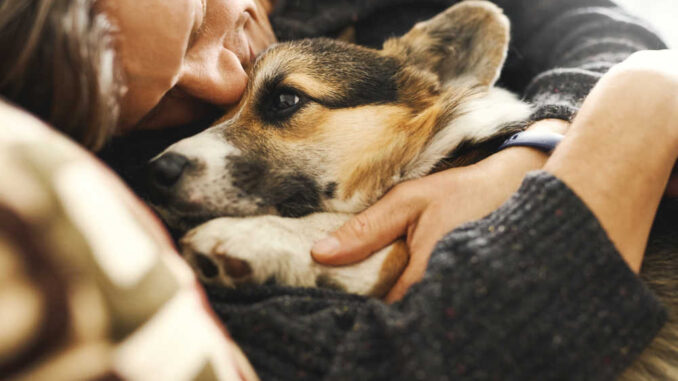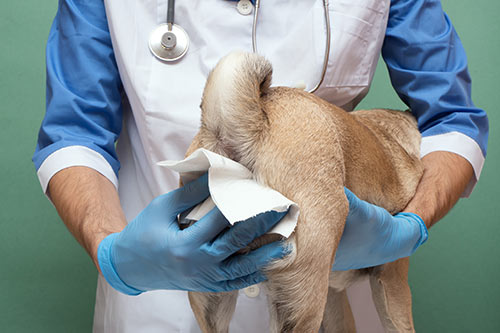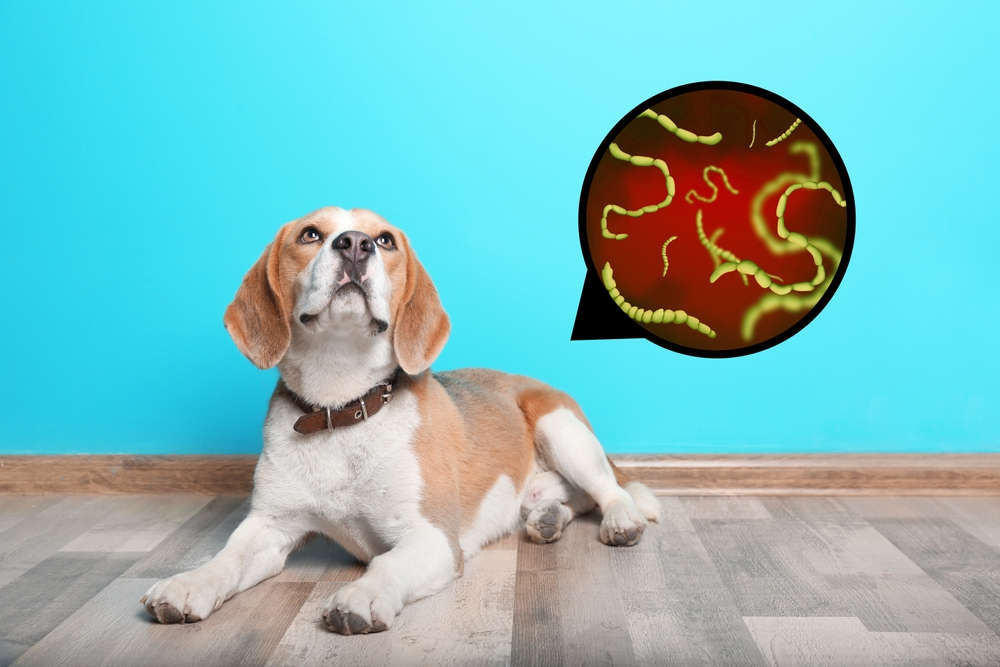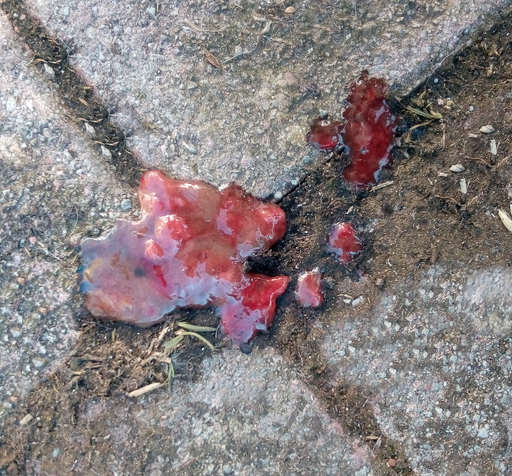
This article was updated on February 18th, 2024
Seeing bright red blood anywhere on your canine companion is enough to send any pet parent into an immediate frenzy, especially if that bright red blood is in your dog’s stool. Not to worry, as a veterinarian, seeing blood is a daily occurrence, even in a dog’s poop. This is known as hematochezia. Here’s what you need to know:
Why is there bright red blood in my dog’s poop? Top Reasons:
There are a multitude of possible reasons for bright red blood in your dog’s bowel movement, but let’s start with some basic information. When bright red blood is present, it means the blood hasn’t gone through the digestive tract – it hasn’t been digested, otherwise it would look dark brown or even black.
“Bright red blood indicates there’s fresh bleeding in the colon or near the exit point.”
Possible causes include:
1. Anal gland issues
Often accompanied by scooting and discomfort, blood from an anal gland issue will appear bright red, may cause blood streaks directly on stool, and there may even be blood on or around the anus. Dogs with a history of anal gland issues are at particular risk, but since all dogs have anal glands, they all could have this issue. Anal glands inflamed enough to bleed may be infected or impacted, both of which requires veterinary treatment.

2. Gastrointestinal disturbances
Anything that causes diarrhea can eventually lead to blood in the stool. With diarrhea comes irritation and straining, both of which can induce bleeding in the colon, rectum or anus.
Abrupt changes in a dog’s diet, or the introduction of new foods or treats, can cause inflammation or a rapid change in normal gut flora. These changes lead to diarrhea which, as outlined above, can cause irritation and blood in the stool. If your dog has diarrhea, click here to find out how to stop diarrhea fast with these home remedies.
3. Minor tears
On the opposite spectrum, constipation can also lead to bright red blood in dog stool. That’s because feces that is too hard or dry or that contains indigestible materials like bones or sticks can cause irritation and even small tears in the lining of the intestine and anus that can bleed.
4. Worms
Without the regular use of veterinary prescribed dewormers, dogs are at risk of picking up, carrying, and even transmitting intestinal parasites. There are a variety of intestinal worms dogs are susceptible to, but the most common culprit of bloody stool could be hookworms. A dog with hookworms may exhibit symptoms such as diarrhea, weight loss, anemia, lethargy. See what dog worms look like. Occasionally, you may also see worms in the dog’s stool.

It’s important to note that many intestinal parasites from dogs can be passed to humans, so here’s another good reason to keep up on regular deworming.
6. Inflammatory conditions
Conditions like colitis or inflammatory bowel disease lead to significant inflammation in the large intestine. These conditions cause swelling and changes to the health of the intestinal tissues, often causing diarrhea, and the diarrhea plus inflammation could easily lead to blood in the stool, as shown in the picture below.

7. Canine parvovirus
This is a serious but preventable viral condition that attacks the lining of the intestines, leading to bloody diarrhea and vomiting. Other symptoms include lethargy, loss of appetite, and dehydration.
Puppies are most often affected, but since parvo is very effectively controlled with proper vaccinations, unvaccinated adult dogs are also at high risk. With immediate veterinary treatment, more than 2/3 of dogs with parvo will survive, but mortality rates for parvo when treated at home are very high.
When is bright blood in dog’s poop an emergency?
While a single episode of intestinal disturbance might not seem like a big deal, blood on your dog’s poop can be an indicator of more significant issues. If you notice any of these signs, be sure to seek veterinary care immediately:
- Severe bleeding or continuous blood – this includes blood on the stool or blood around the anus
- Lethargy, vomiting, or pale gums – these can be indicators that the amount of blood loss is significant and having a negative effect on your dog’s body
- Loss of appetite and/or vomiting – if your dog stops eating at any point, it is cause for concern; it’s also problematic if blood in your dog’s stool is accompanied by vomiting
If your dog has any of these signs, it’s best to get your dog in to see a veterinarian sooner, rather than monitoring at home:
- Bloody bowel movements that persist for more than 24 hours
- Higher frequency of bloody bowel movements
- There is blood present elsewhere, not just on the stool
- There is persistent diarrhea associated with the blood in the stool
- Your dog is constipated and straining to defecate but not passing any stool
- Your dog’s condition worsens
- Additional signs emerge
When is it ok to help my dog at home
While you should always contact your dog’s veterinarian when there are signs of illness, they may recommend you monitor your pet at home if:
- Blood is minimal and occasional.
- Your dog is active and has a normal appetite.
- No other concerning signs are present.
4 tips to help your dog at home
The first steps to helping your pet are to remain calm and think about what your pet needs. While cleaning up blood-streaked poop or profuse diarrhea is unpleasant for us as humans and dog owners, it’s your pet who is sick and in need of care.
Monitor: Keep an eye on your dog’s behavior and stool consistency, stay aware of any changes to their condition, consider taking notes if possible.
Hydration: Ensure access to fresh water to prevent dehydration; commercially produced hydrating drinks aren’t necessarily recommended because the electrolyte content or sweeteners can make the problem worse. If your dog is reluctant to drink water, consider offering low sodium chicken broth, either cool, or warmed quickly in the microwave, or even served up in the form of ice cube treats.
Diet: Offer smaller amounts of your dog’s regular food more frequently. This just helps to spread out the work of the digestive tract in order to give it a small rest.
Rest: Encourage rest and limited activity to aid healing. If you usually walk your dog for potty breaks this is fine, but avoid extended walks, vigorous activity (especially in warm weather) and stay away from public spaces like dog parks, roadways, or shared yards where other pets may wander.
Consider giving your dog probiotics or supplements:
Dog-specific probiotics: Probiotics made for dogs have a specific balance of good bacteria that closely match what is usually in your dog’s intestines. Proper gut bacteria can combat inflammation, diarrhea, and minor causes of rectal irritation that are responsive to probiotics. Probiotics are generally safe and carry few risks even in dogs that are a little under the weather.
- Number one probiotic supplement recommended by veterinarians (Kantar Veterinary Tracker, 2020)
Pro-Pectalin supplements: Products containing kaolin and pectin can help restore normal stool firmness, help balance gut bacteria, and offer a soothing absorbant that reduces inflammation. These products are generally safe and carry few risks. However, you should still consult your vet before giving your dog this type of medication.
- Situational Anti-diarrheal for Dogs and Cats – Contains kaolin and pectin to help firm loose stools and helps soothe your pet’s irritated, unsettled, or upset digestive system.
Canned pumpkin: If your dog’s stools are harder than they should be, or your dog seems a little constipated, canned pumpkin is a simple, easy, and generally safe way to improve the texture of their bowel movements. It’s important to tell the difference between straining from constipation (where no stool is produced, or the stool produced is small and hard) and straining from diarrhea (where persistent straining might occur but soft or liquid diarrhea comes with it). Canned pumpkin will not be beneficial for straining from diarrhea.
- One 15 ounce can of Organic Pumpkin Purée
Finally, regardless of your dog’s symptoms, or signs of improvement, schedule a vet appointment if you notice blood in their stool. Your dog’s veterinarian will be better able to decide if the condition needs treatment, or what the cause is.
Your visit at the vet
When you bring your dog in for blood in the stool, the veterinarian will conduct a thorough physical exam and may recommend additional tests like fecal analysis or blood work to pinpoint the cause of the bleeding. When bringing your dog in, consider collecting a fresh sample of stool to take with you.
The average veterinary exam can range between $50 to $250 depending on your region, and the nature of the visit (an emergency vet visit at a specialty center will be more expensive than a routine examination).
“Collect a fresh stool sample for analysis before your visit to the vet – this sample shouldn’t be more than a couple hours old by the time your dog’s appointment comes around. For best results, refrigerate the sample and gather at least a couple of teaspoons worth.”
Questions your vet will ask you
- When did you first notice the blood? How long has it been going on? How frequently are you seeing it?
- Any recent dietary changes or new treats? Has your dog eaten anything they shouldn’t, including paper products, toys, or garbage?
- Have there been any changes in behavior? Does your dog seem quieter or more sensitive than usual?
- Is your dog on any medications or supplements? (this includes medications they’re on long-term, and any medications or supplements you may have given when your dog first appeared unwell)
- Are there any signs you’re seeing in addition to the blood, such as diarrhea, constipation, changes in appetite, etc?
Diagnosis & cost of diagnosis
Once the exam is completed and you’ve given the veterinary team the answers they need, they will likely recommend some testing to narrow down causes and formulate a plan to treat your beloved pet. The veterinarian will decide which of the following tests to run, depending on how severe your dog’s symptoms are:
- Fecal analysis: $20 – $50
- Blood work: $100 – $300 (costs vary depending on your region and what tests are needed)
- Fecal sample staining: $25 – 75 (this test looks at intestinal bacteria to determine if there’s an imbalance)
- X-rays: $200 – 400 (especially if there is abdominal pain or significant constipation, x-rays will show your veterinarian how things are or aren’t working internally; multiple x-ray views are absolutely necessary for proper diagnosis)
- Ultrasound $200 – 500 (working different from x-rays, the ultrasound offers a more focused view on what’s happening with the tissues in your dog’s abdomen, including the stomach, intestines, and even other organs like the liver and kidneys, or pancreas.)
While it’s unlikely your dog’s veterinarian will recommend ALL of these tests, you might expect the diagnostics to cost somewhere between $150 – 800, with more severe cases requiring more diagnostics. All of these costs are in addition to the exam, and cost for treatment will be additional.
Veterinary treatments and costs
The cost of treatment will vary depending on the severity of your dog’s conditions. Mild cases may only require outpatient care, which can vary between $100 and $500 depending on your dog’s size, the cause of the diarrhea, and whether or not supplemental hydration is needed.
More severe cases might require in-hospital care. While some dogs may only need a few hours of hospitalization, fluids, and other treatments, serious cases might require multiple days of care. The costs can range anywhere from $500 – $2500.
If the blood in your dog’s stool is caused by parvovirus, in-hospital care will likely cost between $2500 and $5000 depending on how long they have to stay (some dogs need care for over a week)
Pictures of dog poop with bright red blood:
1. Bright red blood on or in dog poop

2. Bright red bloody streaks in dog poop

Type 3. Raspberry jam texture blood in dog’s poop

Type 4. Pure blood

Prognosis
The prognosis for blood in your dog’s stool can be good, if you seek proper veterinary treatment for it early on. Mild cases treated promptly often fare really well.
Severe cases that are not treated quickly by a veterinarian, though, do have a good chance of complications that may be dangerous.
Disclaimer: This website's content is not a substitute for veterinary care. Always consult with your veterinarian for healthcare decisions. Read More.







Be the first to comment